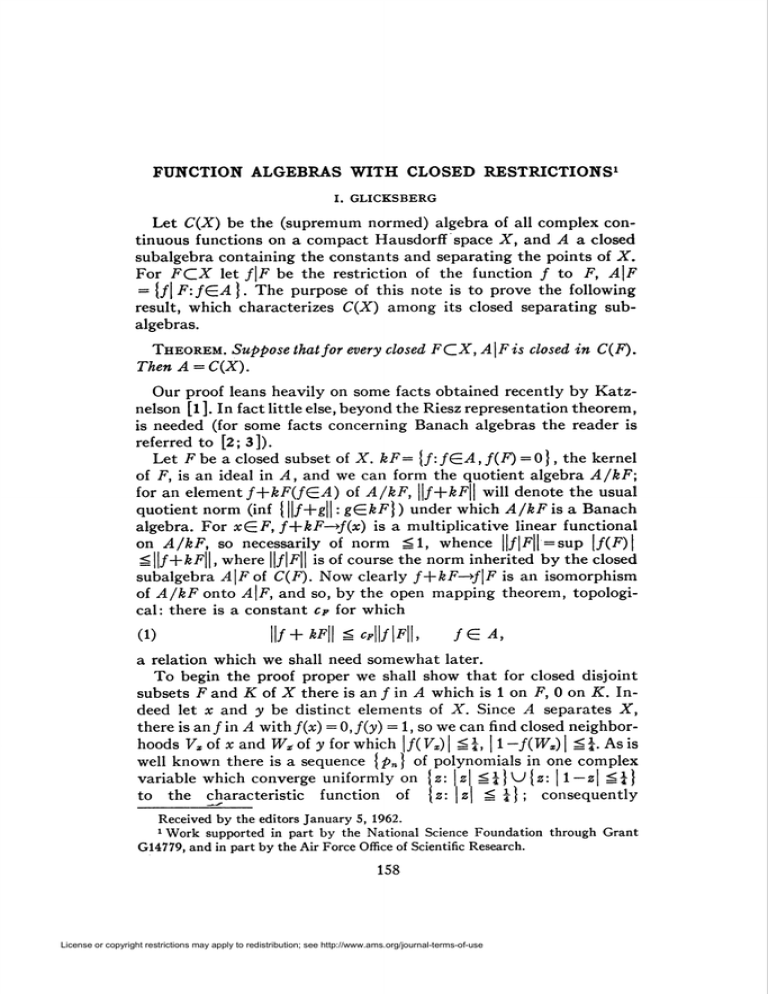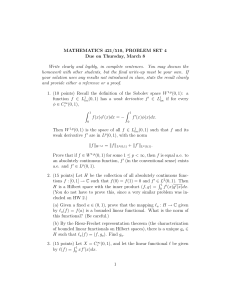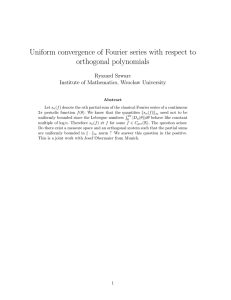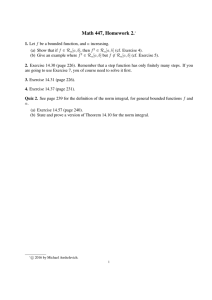FUNCTION ALGEBRAS WITH CLOSED RESTRICTIONS1 (1) \\f + kF
advertisement

FUNCTION ALGEBRAS WITH CLOSED RESTRICTIONS1
I. GLICKSBERG
Let CiX) be the (supremum normed) algebra of all complex continuous functions on a compact Hausdorff space X, and A a closed
subalgebra containing the constants and separating the points of X.
For FEX
let f\F be the restriction of the function / to 7% A\F
= {/| F:fEA}.
The purpose of this note is to prove the following
result, which characterizes
CiX) among its closed separating sub-
algebras.
Theorem.
Suppose that for every closed FEX,A\Fis
closed in CiF).
Then A = CiX).
Our proof leans heavily on some facts obtained recently by Katznelson [l ]. In fact little else, beyond the Riesz representation theorem,
is needed (for some facts concerning Banach algebras the reader is
referred to [2; 3]).
Let F be a closed subset of X. kF= [f:fEA,fF)
= 0}, the kernel
of F, is an ideal in A, and we can form the quotient
algebra A/kF;
for an element f+kFifEA)
of A/kF, \\f+kF\\ will denote the usual
quotient norm (inf {||/+g|| : gEkF) ) under which A/kF is a Banach
algebra. For xEF, /+£P—>/(x) is a multiplicative
linear functional
on A/kF, so necessarily of norm gl, whence |[/|p||=sup
|/(F)|
fg||/-|-JkF||, where ||/|P|| is of course the norm inherited by the closed
subalgebra A\F oí CiF). Now clearly f-\-kF—*f\F is an isomorphism
of A/kF onto ^4|P, and so, by the open mapping theorem, topological: there is a constant Cf for which
(1)
\\f + kF¡\ ^ cF\\f\F\\,
fEA,
a relation which we shall need somewhat later.
To begin the proof proper we shall show that for closed disjoint
subsets F and K of X there is an / in A which is 1 on F, 0 on K. Indeed let x and y be distinct elements of X. Since A separates X,
there is an / in A with /(x) = 0, f(y) = 1, so we can find closed neighbor-
hoods V, of x and Wxof y for which |/( 7.) | á 1, 11~fWx) | ^ J. As is
well known there is a sequence {pn} of polynomials in one complex
variable which converge uniformly on \z: \z\ ^i}W{z:
11— z\ á|}
to the characteristic
function
of [z: \z\ Ú l] ; consequently
Received by the editors January 5, 1962.
1 Work supported
in part by the National
Science Foundation
G14779, and in part by the Air Force Office of Scientific Research.
158
License or copyright restrictions may apply to redistribution; see http://www.ams.org/journal-terms-of-use
through
Grant
FUNCTIONALGEBRASWITH CLOSEDRESTRICTIONS
159
{(Pn of) | (VX\JWX) ] is a sequence of elements of A \ (VX\JWX) which
converges uniformly on VXVJWX,tending to 1 on Vx, 0 on Wx. Since
A | ( VX\J Wx) is closed under uniform convergence by hypothesis,
there is an e in A which is 1 on Vx, 0 on Wx.
Now let y be a fixed element of K. F can be covered by finitely
many Vx, xEF, say VXi, • - - , VXn.If ex, • • • , en are the corresponding elements of A, then (as in a familiar argument) clearly e{ =ex+e2
—exe2 is 1 on VXl\JVXl and 0 on the neighborhood
WXlC\WXt of y;
similarly ei =e[ +e3 —e{e3 is 1 on VXl\J V^VJ Vxzand 0 on WXlf~\WXt
C\WXi. Continuing we thus obtain an element fv of A which is 1 on
P, and vanishes on some neighborhood
Uv of y.
But now finitely many Uv cover K, so that the product/ of the corresponding /„ yields an element of A which is 1 on P and 0 on K, as
desired.
Alternatively stated, we have found an idempotent in A/k(K\JF)
which separates P and K. What we now require is a bound on the
norms of such idempotents, and to obtain this we repeat an argument
of Katznelson's
[l, Lemmas 3, 4, 5]. Let us say A is bounded on a
subset V of X il there is a constant Cy for which, whenever F is closed
and FEV, any idempotent
in A/kF has norm <Cr. (Our next
lemmas are taken from Katznelson [l], and are repeated here for the
convenience of the reader.)
Lemma 1. Let Vxand V2 be open in X, and A be bounded on each F¿.
Then A is bounded on every closed subset F of FtVJ F2.
Proof. Since P\F2 is a closed subset of Fi we can find an open
WxDF\V2, Wx'EVx; and since F\WxE V2there is an open W2DF\WU
W2 C V2. F\Wx and F\W2 are disjoint
closed subsets
of X so there is
a 0 in A for which <¡>(F\Wx)= 0, <¡>(F\W2)= 1, as we have seen.
Let P be a closed subset of F and let f-\-kP be an idempotent
in
A/kP, so / is zero or 1 at each point of P. Then f-\-k(P(~\W7)
is an
idempotent
in A/k(P(~\W7)
and so (by the definition of the quotient
norm) we can choose fiEf+HPHWT)
a closed subset of F,-, i=i,
PCP£lFiUIF2,
with ||/J| <CV(,PC\W7 being
2. But now/=<£/i
+ (l— 4>)f2on P, since
and thus
||/+ kP\\ =g d*/! + (1 - *)/2|| < \\4>\\CVl+ ||l - *||cFf
so the right side may be taken as Cp.
Still following Katznelson let us say A is bounded at xEX if A is
bounded on V, for some neighborhood
V of x. Then as an obvious
consequence of Lemma 1 and compactness we have
Lemma 2. If F is closed and A is bounded at each x in F there is an
License or copyright restrictions may apply to redistribution; see http://www.ams.org/journal-terms-of-use
160
I. glicksberg
[February
open VZ)F on which A is bounded.
Lemma 3. There are at most finitely many x in X at which A is not
bounded.
Proof. If there were infinitely many we could find a sequence {x„}
of them with disjoint open neighborhoods
{ F„} for which A is not
bounded on Vn. So each Vn would contain a closed Fn for which there
is an idempotent/n+fe^n
in A/kFn of norm ^».
Now let F = (UP„)-; since VnC\ Fm= 0 for » ^ m, F = Fn
^(Um?¡n Fm)~, P„P\(Ump!„F„)- = 0 and thus there is a <bin A with
<¡>(Fn)= 1, <b(F\Fn) = 0. Consequently
<£/„ is zero or 1 at each x in F,
and tf>fn+kF is an idempotent in A/kF; but
n g II/.+ *F.||= Ufn+ kFn\\á Ufn+ kF\\
(since kFEkF„)
so the idempotents
in A/kF are not bounded in
norm. By (1) they must be bounded, and the lemma is proved.
Let {xi, • • • , x„} be the finite set given by Lemma 3 and let F
be any closed set in X disjoint from {xi, • • • , x„}. By Lemma 2,
A is bounded on a neighborhood of F; so there is a constant Cp for
which, whenever K is closed, KQF, each idempotent in A/kK has
norm <Cf.
Now suppose p is a (complex regular Borel) measure on F orthogonal to the closed subalgebra A \ F of CiF), and let K be a closed subset of F, e>0. Choose a closed K0EF\K
for which the total variation
of p on iF\K)\Ko
is less than e/Cp, and then choose fEA which is
1 on K, 0 on K0, and of norm < CF. Then
0 = f fdp= f Un+ f Odu
+f
so |/t(-K)| —\f(F\K)\Ktfdp\ =Cye/Citrary, fiK = 0 for every closed KEF,
fdu,
= €. Thus since e>0 is arbiand /x itself vanishes by regular-
ity. Consequently A \ F= CiF).
Now this implies any measure ß orthogonal to A is carried by
IXi, • • • , xn\. For if not fiF^O for some closed F disjoint from
Xi, • • • , x„} by regularity, and if V is an open neighborhood of
Xi, • • • , x„) with V~r\F= 0, we can choose /G^4 with/(F~)=0,
/(F) = 1; then fp (the measure corresponding
to the functional
g-^fgfdp on C(X)) is a measure carried by X\V, and orthogonal to
A and so orthogonal to A \ (X\V) = C(X\V), hence the zero measure.
But fp(F)=f pfdp = pFt¿0, the desired contradiction, and p orthogonal to A must be carried by {Xi, • • • , x„}.
License or copyright restrictions may apply to redistribution; see http://www.ams.org/journal-terms-of-use
i96j]
FUNCTION ALGEBRASWITH CLOSEDRESTRICTIONS
161
Since A separates the points of X this is clearly impossible unless
all orthogonal measures vanish, i.e., unless A = C(X), which completes
the proof of the theorem.
References
1. Y. Katznelson,
A characterization
of the algebra of all continuous functions on a
compact Hausdorff space, Bull. Amer. Math. Soc. 66 (1960), 313-315.
2. L. H. Loomis, Abstract harmonic analysis, Van Nostrand, New York, 1953.
3. C. Rickart, General theory of Banach algebras, Van Nostrand, New York, 1960.
Institute
for Advanced Study
License or copyright restrictions may apply to redistribution; see http://www.ams.org/journal-terms-of-use






